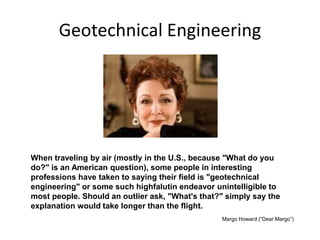The Basic Principles Of Geotheta
The Basic Principles Of Geotheta
Blog Article
Some Of Geotheta
Table of Contents6 Easy Facts About Geotheta DescribedAn Unbiased View of GeothetaUnknown Facts About GeothetaThe Definitive Guide to GeothetaSome Of Geotheta

They carry out website examinations, collect samples, execute research laboratory tests, and assess data to review the viability of the ground for construction jobs - Engineer of Record. Based on their findings, geotechnical designers supply recommendations for foundation style, slope security, keeping frameworks, and reduction of geotechnical threats. They work together with various other specialists, such as architects, structural engineers, and building groups, to ensure that geotechnical considerations are incorporated into the total project layout and application
By analyzing the actions and buildings of soil and rock, they can identify potential geotechnical hazards such as landslides, soil settlement, or incline instability. Their competence assists protect against failings or mishaps that might threaten lives and residential or commercial property. Here are some detailed responsibilities and obligations of a geotechnical engineer: Website Examination: Geotechnical engineers conduct site investigations to gather data on subsurface problems.
They translate the data to understand the buildings and habits of the dirt and rock, including their strength, permeability, compaction attributes, and groundwater conditions. Geotechnical Evaluation and Design: Geotechnical engineers evaluate the information accumulated throughout site examinations to evaluate the stability and viability of the website for building tasks. They perform geotechnical computations and modeling to review variables such as bearing capability, negotiation, incline stability, lateral earth stress, and groundwater circulation.
Geotheta for Beginners
Foundation Layout: Geotechnical engineers play a crucial role in developing structures that can safely support the intended structure. They examine the dirt conditions and tons requirements to determine the ideal structure kind, such as superficial foundations (e.g., footings), deep foundations (e.g (https://www.blogtalkradio.com/geotheta)., piles), or specialized strategies like soil improvement. They consider variables such as settlement limits, bearing capacity, and soil-structure interaction to establish ideal foundation designs
They evaluate building plans, monitor website activities, and carry out field assessments to confirm that the style suggestions are complied with. If unanticipated geotechnical concerns emerge, they analyze the scenario and provide recommendations for removal or adjustments to the design. Threat Evaluation and Mitigation: Geotechnical engineers assess geotechnical dangers and risks linked with the project website, such as landslides, liquefaction, or dirt erosion.

Partnership and Interaction: Geotechnical engineers function carefully with other experts included in a job, such as architects, architectural engineers, and construction teams. Reliable communication and cooperation are necessary to integrate geotechnical considerations right into the find more info overall project layout and building and construction procedure. Geotechnical designers offer technological competence, answer queries, and ensure that geotechnical needs are fulfilled.
The Main Principles Of Geotheta
Here are some kinds of geotechnical designers: Structure Engineer: Structure designers specialize in designing and assessing foundations for structures. They analyze the dirt conditions, load demands, and site features to determine the most ideal foundation type and design, such as superficial foundations, deep foundations, or specialized strategies like heap foundations.
They examine the variables influencing slope security, such as dirt buildings, groundwater conditions, and slope geometry, and develop approaches to stop incline failures and reduce risks. Quake Designer: Quake designers specialize in assessing and developing structures to stand up to seismic pressures. They analyze the seismic threat of a site, examine dirt liquefaction potential, and establish seismic design criteria to guarantee the safety and security and durability of frameworks during earthquakes.
They execute field screening, accumulate samples, and analyze the gathered information to identify the dirt homes, geologic developments, and groundwater problems at a website. Geotechnical Instrumentation Engineer: Geotechnical instrumentation designers concentrate on monitoring and measuring the habits of dirt, rock, and structures. They set up and maintain instrumentation systems that monitor variables such as dirt negotiation, groundwater levels, incline activities, and architectural displacements to evaluate performance and offer very early warnings of prospective problems.
The 25-Second Trick For Geotheta
They perform tests such as triaxial examinations, loan consolidation examinations, direct shear examinations, and permeability examinations to gather information for geotechnical evaluation and style. Geosynthetics Designer: Geosynthetics designers specialize in the layout and application of geosynthetic materials, such as geotextiles, geogrids, and geomembranes. They utilize these materials to boost dirt security, strengthen slopes, give drainage remedies, and control erosion.
They often tend to be investigative people, which means they're intellectual, reflective, and investigative. They are curious, systematic, rational, logical, and sensible. Some of them are additionally social, meaning they're kind, charitable, participating, patient, caring, handy, understanding, sensible, and friendly - Geo Tech Engineer.
In the workplace setting, geotechnical engineers make use of specialized software tools to do computations, create designs, and evaluate data. They prepare records, evaluation task requirements, interact with clients and staff member, and coordinate project tasks. The workplace setup gives a helpful setting for study, analysis, and cooperation with other experts associated with the project.
The Single Strategy To Use For Geotheta
They regularly go to job websites to conduct website examinations, evaluate geotechnical conditions, and gather information for analysis. These sees entail traveling to various locations, occasionally in remote or tough terrains. Geotechnical designers may do dirt tasting, conduct tests, and monitor building and construction activities to make sure that the geotechnical facets of the project are being applied appropriately.
Geotechnical designers additionally operate in specialized geotechnical labs. In these facilities, they conduct experiments, carry out examinations on dirt and rock samples, and examine the engineering properties of the materials. Geotechnical lab designers function extensively in these settings, handling testing devices, running tools, and videotaping information. They collaborate with other laboratory personnel to make sure accurate and reliable testing results.
Report this page